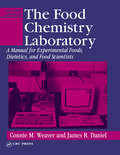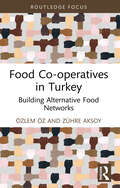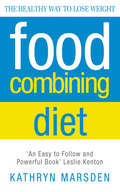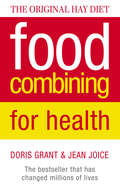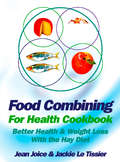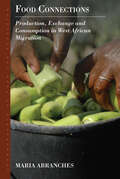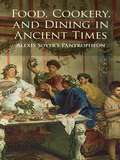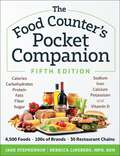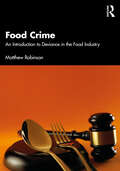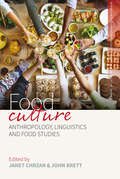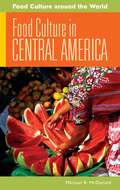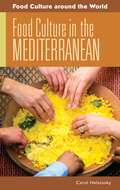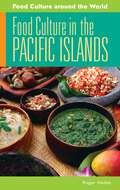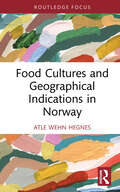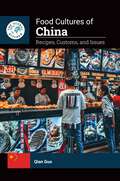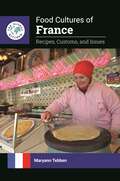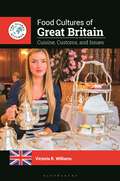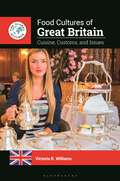- Table View
- List View
The Food Chemistry Laboratory: A Manual for Experimental Foods, Dietetics, and Food Scientists, Second Edition (Contemporary Food Science Ser.)
by Connie M. Weaver James R. DanielA popular book in its first edition, The Food Chemistry Laboratory: A Manual for Experimental Foods, Dietetics, and Food Scientists, Second Edition continues to provide students with practical knowledge of the fundamentals of designing, executing, and reporting the results of a research project. Presenting experiments that can be completed, in many
Food Co-operatives in Turkey: Building Alternative Food Networks (Routledge Focus on Environment and Sustainability)
by Özlem Öz Zühre AksoyThis book addresses the roles played by food co-operatives in the attempt to build alternative food networks, drawing on an in-depth analysis of case studies in Turkey. While many existing studies focus on food co-operatives and alternative food networks in the Global North, this book provides an important insight into a country from the Global South and, in doing so, not only provides a novel perspective but also challenges the rigid North–South categorization. The book provides a rounded view by examining both a producer and a consumer co-operative: BÜKOOP is a university-based consumer food co-operative, and the Vakıflı co-operative is a food-producing co-operative located in the Hatay province on the Mediterranean coast of Turkey. These two co-operatives, which have been working together for more than ten years, share the dream of establishing a network of co-operatives, in which producers exist in solidarity with consumers, blurring the dichotomy of producer versus consumer as well as rural versus urban. In addition to contributing towards a better understanding of the urban–rural divide, within the framework of alternative food networks, the in-depth analysis of these two cases enables us to explore how food co-operatives develop and how they keep their commitment to their original goals and ideals so as to help build an alternative food system. The lessons we learn from these two working case examples highlight the successes and areas of improvement for food co-operatives. They also provide evidence against the pessimism about alternative food networks by demonstrating that co-operatives can democratize both production and consumption. This book will be of interest to students and scholars studying alternative food networks, food justice, food sovereignty, transformation towards sustainable food systems, social movements, and the urban–rural divide.
Food Co-operatives in Turkey: Building Alternative Food Networks (Routledge Focus on Environment and Sustainability)
by Özlem Öz Zühre AksoyThis book addresses the roles played by food co-operatives in the attempt to build alternative food networks, drawing on an in-depth analysis of case studies in Turkey. While many existing studies focus on food co-operatives and alternative food networks in the Global North, this book provides an important insight into a country from the Global South and, in doing so, not only provides a novel perspective but also challenges the rigid North–South categorization. The book provides a rounded view by examining both a producer and a consumer co-operative: BÜKOOP is a university-based consumer food co-operative, and the Vakıflı co-operative is a food-producing co-operative located in the Hatay province on the Mediterranean coast of Turkey. These two co-operatives, which have been working together for more than ten years, share the dream of establishing a network of co-operatives, in which producers exist in solidarity with consumers, blurring the dichotomy of producer versus consumer as well as rural versus urban. In addition to contributing towards a better understanding of the urban–rural divide, within the framework of alternative food networks, the in-depth analysis of these two cases enables us to explore how food co-operatives develop and how they keep their commitment to their original goals and ideals so as to help build an alternative food system. The lessons we learn from these two working case examples highlight the successes and areas of improvement for food co-operatives. They also provide evidence against the pessimism about alternative food networks by demonstrating that co-operatives can democratize both production and consumption. This book will be of interest to students and scholars studying alternative food networks, food justice, food sovereignty, transformation towards sustainable food systems, social movements, and the urban–rural divide.
Food Combining: Lose Weight with Food Combinations that Work for Your Body (Wellbeing Quick Guides)
by Liz EarleLiz Earle explains the science behind food combining and shows you how smart combinations can improve digestion and nutrition, promote weight loss and help you to feel great.Bestselling beauty and wellbeing writer Liz Earle's fully revised and updated quick guide to the principles of food combining, including:- The science behind food combining and how separating protein and carbohydrates can improve digestion and boost weight loss- A guide to the food groups, including information about acid and alkaline-forming foods- Tips and advice on how to incorporate the principles of food combining into your everyday life - Delicious recipes including Lemon Chicken, Prawn Kebabs with Herb Dressing, and Spiced Bananas
Food Combining Diet: The Healthy Way To Lose Weight
by Kathryn MarsdenThis bestselling weight loss title has sold over 250,000 copies. Adapting Dr Hay’s teachings – separating protein and starch for optimum health – respected nutritionist Kathryn Marsden provides advice and easy recipes to help you lose weight easily, naturally, safely and healthily.
Food Combining for Health: The Bestseller That Has Changed Millions Of Lives
by Doris Grant Jean JoiceThe international best-selling guide to how the Hay diet (food combining) can improve health and vitality. With over one million copies sold worldwide, this is the ultimate guide to the health benefits of food combining from two of the most respected authors in the field.
Food Combining for Health Cookbook: Better Health And Weight Loss With The Hay Diet
by Jean Joice Jackie Le TissierFrom the best selling authors of Food Combining for Health and Food Combining For Vegetarians and with a foreword by Doris Grant – the Food Combining for Health Cookbook is the definitive recipe collection and nutrition guide for food combiners.
Food Connections: Production, Exchange and Consumption in West African Migration (Anthropology of Food & Nutrition #10)
by Maria AbranchesFood Connections follows the movement of food from its production sites in West Africa to its final spaces of consumption in Europe. It is an ethnographic study of economic and social life amongst a close-knit community of food producers, traders and consumers and a wide range of small intermediaries that operate in Guinea-Bissau and Portugal. By investigating the way meanings of food and land are embedded in everyday experiences and relationships in the various phases of the movement, on both sides of the migration, it reveals the connections that transnational processes of food production, exchange and consumption generate between two lifeworlds.
Food Connections: Production, Exchange and Consumption in West African Migration (Anthropology of Food & Nutrition #10)
by Maria AbranchesFood Connections follows the movement of food from its production sites in West Africa to its final spaces of consumption in Europe. It is an ethnographic study of economic and social life amongst a close-knit community of food producers, traders and consumers and a wide range of small intermediaries that operate in Guinea-Bissau and Portugal. By investigating the way meanings of food and land are embedded in everyday experiences and relationships in the various phases of the movement, on both sides of the migration, it reveals the connections that transnational processes of food production, exchange and consumption generate between two lifeworlds.
Food, Cookery, and Dining in Ancient Times: Alexis Soyer's Pantropheon
by Alexis Soyer"Tell me what thou eatest," Alexis Soyer declared in a familiar refrain, "and I will tell thee who thou art." In his book Pantropheon, originally published in 1853, the flamboyant Frenchman (and world's first celebrity chef) ventures to answer that question as he presents a wealth of entertaining and enlightening information on what food the people of ancient civilizations ate and how they prepared it.Describing the culinary achievements of the Greeks, Romans, Assyrians, Egyptians, and Jews, Soyer covers such topics as the mythological origin of specific foods (pomegranates and eels, for example); agricultural, milling, and marketing practices; descriptions of seasonings, pastries, and exotic dishes; the treatment of dinner guests; as well as suggestions for serving pigeon, peacock, wild boar, camel, elephant, flamingo, and other wildlife.Enhanced by 38 illustrations depicting food-related objects and antiquity's gastronomic wonders, this witty and literal study of epicurean delights will charm history buffs and food enthusiasts alike.
The Food Counter's Pocket Companion, Fifth Edition: Calories, Carbohydrates, Protein, Fats, Fiber, Sugar, Sodium, Iron, Calcium, Potassium, and Vitamin D
by Jane Stephenson Rebecca LindbergAn updated edition of a handy pocket nutrition guide for easily checking the nutrient values of over 4,500 foods, 100s of brands, and 30 fast food restaurant chains—with over 100,000 total copies of previous editions sold
Food Crime: An Introduction to Deviance in the Food Industry
by Matthew RobinsonThis book addresses the various forms of deviance and criminality found within the conventional food system. This system—made up of numerous producers, processors, distributors, and retailers of food—has significant, far-reaching consequences bearing upon the environment and society.Food Crime broadly outlines the processes and impacts of this food system most relevant for the academic discipline of criminology, with a focus on the negative health outcomes of the US diet (e.g., obesity and diabetes) and negative outcomes associated with the system itself (e.g., environmental degradation). The author introduces the concept of "food criminology," a new branch of criminology dedicated to the study of deviance in the food industry. Demonstrating the deviance and criminality involved in many parts of the conventional food system, this book is the first to provide exhaustive coverage of the major issues related to what can be considered food crime. Embedded in the context of state-corporate criminality, the concepts and practices exposed in this book bring attention to harms associated with the conventional food system and illustrate the degree of culpability of food companies and government agencies for these harms.This book is of interest to students, scholars, and practitioners seeking a more just and healthy food system and encourages further future research into food crimes in the disciplines of criminology, criminal justice, and sociology.
Food Crime: An Introduction to Deviance in the Food Industry
by Matthew RobinsonThis book addresses the various forms of deviance and criminality found within the conventional food system. This system—made up of numerous producers, processors, distributors, and retailers of food—has significant, far-reaching consequences bearing upon the environment and society.Food Crime broadly outlines the processes and impacts of this food system most relevant for the academic discipline of criminology, with a focus on the negative health outcomes of the US diet (e.g., obesity and diabetes) and negative outcomes associated with the system itself (e.g., environmental degradation). The author introduces the concept of "food criminology," a new branch of criminology dedicated to the study of deviance in the food industry. Demonstrating the deviance and criminality involved in many parts of the conventional food system, this book is the first to provide exhaustive coverage of the major issues related to what can be considered food crime. Embedded in the context of state-corporate criminality, the concepts and practices exposed in this book bring attention to harms associated with the conventional food system and illustrate the degree of culpability of food companies and government agencies for these harms.This book is of interest to students, scholars, and practitioners seeking a more just and healthy food system and encourages further future research into food crimes in the disciplines of criminology, criminal justice, and sociology.
Food Culture: Anthropology, Linguistics and Food Studies (Research Methods for Anthropological Studies of Food and Nutrition #2)
by Janet Chrzan John BrettThis volume offers a comprehensive guide to methods used in the sociocultural, linguistic and historical research of food use. This volume is unique in offering food-related research methods from multiple academic disciplines, and includes methods that bridge disciplines to provide a thorough review of best practices. In each chapter, a case study from the author's own work is to illustrate why the methods were adopted in that particular case along with abundant additional resources to further develop and explore the methods.
Food Culture in Central America (Food Culture around the World)
by Michael R. McDonaldThis entry in the Food Culture around the World series helps those in the United States understand the new immigrants from Central America who have brought their food cultures with them.Food Culture in Central America illustrates the unique foodways of the region in depth—and in English—for the first time. Important foods and ingredients, techniques, and lore associated with food preparation are surveyed. Typical meals eaten at home are presented, with attention to the cultural context in which those meals take place, including regional or national differences. The book also examines various meal settings—street vendors, modest comedors, and fancy restaurants. The role of food in common festivals and life cycle rituals is explored as well, including Christmas, Semana Santa, and Quincineras.Author Michael R. McDonald emphasizes the living process of "metatezation," referring to the use of the traditional metate, a stone platform used to grind ingredients, resulting in the unique flavors and textures of the cuisines. The process echoes the concept of "mestizaje," the intense hybrid mixture of identities throughout Latin America, which is also explained.
Food Culture in the Mediterranean (Food Culture around the World)
by Carol HelstoskyFood that originated from the Mediterranean area is incredibly popular. Pasta, pizza, gyros, kebab, and falafel can be found just about everywhere. Many people throughout the world have a good idea of what Mediterranean cuisine and diet are all about, but they know less about the entire food culture of the region. This one-stop source provides the broadest possible understanding of food culture throughout the region, giving a variety of examples and evidence from the southern Mediterranean or North Africa (Morocco, Algeria, Tunisia, Libya, and Egypt), the Western Mediterranean or European side of the Mediterranean (Spain, France, Italy, and the French and Italian islands), to the eastern Mediterranean or Levant (Greece, Turkey, Syria, Lebanon, and Israel).The Mediterranean region region is home to three of the world's major religions, and for centuries, the Mediterranean Sea has been an invitation to trade, travel, conquest, and immigration. Where different cultures, beliefs, and traditions mix there is always volatility and tension, but there is also great energy. Understanding the food culture in the Mediterranean is one way readers can see how people of different regions come together, share ideas and information to create new dishes, meals, traditions, and forms of sociability. This volume answers questions such as Do people in the Mediterranean still eat the Mediterranean Diet or do they eat American style? Why is it that the same ingredients can be prepared in so many different ways, even in the same country? Why would cooks take the time to make foods like zucchini, lentils, or figs into dozens of different dishes? How and why do religious rituals differ regarding food preparation? What do Jews, Muslims, and Christians eat on religious holidays? Do people eat out or eat at home? Why is hospitality so important to Mediterranean people and what do they do to demonstrate hospitality and good will through the preparation and serving of meals?
Food Culture in the Pacific Islands (Food Culture around the World)
by Roger HadenThe food culture of the Pacific Islands has been determined by isolation from the rest of the world. Original immigrants from Asia brought their foods, animals, and culinary skills with them, then for several thousand years, they were largely uninfluenced by outsiders. The tropical climate of much of the region, unique island geology and environmental factors also played a role in the evolution of islander cuisine, which is based on unique ingredients. The staples of breadfruit, yams, taro, coconut, sweet potato, and cassava are incorporated into a cuisine that uses cooking and preservation techniques unique to Polynesia, Micronesia, and Melanesia. Today, food culture in the Pacific is largely one of extremes. Although traditional foods and cookery survive and are highly valued, Westernization has meant that the overall diet of islanders has been negatively transformed and that islands are net importers of unhealthful foods. Ironically, the tourism industry has re-engaged islander people in food production and boosted their sense of identity. Students, food mavens, and travellers will find this to be a stellar introduction to the current culture of the Pacific Islands, with discussion of Hawaii, Australia, and New Zealand included. Chapter 1, Historical Overview, offers a fascinating chronicle of the evolution of a food culture of extremes, of isolation, climate, environment, and Western influences. Chapter 2, Major Foods and Ingredients, introduces a host of traditional tropical manna as well as imported products. The Cooking chapter discusses the truly unique cooking styles of the islands, such as steam-baking in the ground in an umu (oven). Chapter 4, Typical Meals, largely explores the emphasis on the ubiquitous processed foods. A Regional Specialties chapter reveals both pan-regional dishes and the noted local dishes. Chapter 6's Eating Out discussion shows the new acceptance of the individualist, recreational ritual of eating away from the community. The typical life-cycle food rituals are covered in the Special Occasions chapter. A final chapter on Diet and Health highlights the increase in Western diseases arising from diet and lifestyle changes and discusses timely food security issues as well. Recipes are interspersed throughout, and a timeline, glossary, selected bibliography, and photos round out the coverage.
Food Cultures and Geographical Indications in Norway (Routledge Focus on Environment and Sustainability)
by Atle Wehn HegnesThis book analyses the implementation and challenges of using Geographical Indications in Norway. Adapting the modern and global system of Geographical Indications (GIs) to food cultures is a recurring challenge. This text uses Norway as a case study to describe, understand, and explain the socio-cultural adaptation of GIs. The empirical analysis shows that administrators, producers, consultants, and others make a significant effort to adapt the scheme to Norwegian food culture and the food culture to the scheme. Through the development and use of a new conceptual framework, the book continues to show how adaptations occurred and their influence on the development of the Norwegian food culture. The author also reflects upon the status of Norwegian GIs in emerging food cultural contexts related to sustainable and technology change. In summary, this book exhibits the connection between modern global legislative arrangements and traditional local products, providing a springboard for further research on cultural adaptation work of GIs in established and future global food cultures. This book will be of interest to researchers, policymakers, and students in agri-food studies, sociology of food and agriculture, agricultural and rural development, and cultural studies.
Food Cultures and Geographical Indications in Norway (Routledge Focus on Environment and Sustainability)
by Atle Wehn HegnesThis book analyses the implementation and challenges of using Geographical Indications in Norway. Adapting the modern and global system of Geographical Indications (GIs) to food cultures is a recurring challenge. This text uses Norway as a case study to describe, understand, and explain the socio-cultural adaptation of GIs. The empirical analysis shows that administrators, producers, consultants, and others make a significant effort to adapt the scheme to Norwegian food culture and the food culture to the scheme. Through the development and use of a new conceptual framework, the book continues to show how adaptations occurred and their influence on the development of the Norwegian food culture. The author also reflects upon the status of Norwegian GIs in emerging food cultural contexts related to sustainable and technology change. In summary, this book exhibits the connection between modern global legislative arrangements and traditional local products, providing a springboard for further research on cultural adaptation work of GIs in established and future global food cultures. This book will be of interest to researchers, policymakers, and students in agri-food studies, sociology of food and agriculture, agricultural and rural development, and cultural studies.
Food Cultures of China: Recipes, Customs, and Issues (The Global Kitchen)
by Qian GuoExploring the rich and varied culinary traditions of China, this book enables a better understanding of Chinese history and culture through food.Part of Bloomsbury's Global Kitchen series, this book takes readers on a food tour of China, covering everything from daily staples to holiday specialties. In addition to discovering China's long culinary history, you'll learn about recent trends, foreign influences, and contemporary food and dietary concerns, such as obesity and environmental sustainability.Chapters are organized thematically, making it easy to focus in on particular courses or types of dishes. For those hungry for a more hands-on approach, each chapter includes a collection of accessible recipes that allow readers to bring the subject to life in their own kitchens. The main text is supplemented by sidebars that offer interesting bite-sized facts, a chronology of important dates in China's culinary history, and a glossary of key food- and dining-related terms. Sun Yat-sen, the founding father of modern China, asserted that China's food culture was the most advanced and sophisticated in the world, despite the country lagging the West in science, industry, and civic engagement. Today, many people outside China immediately envision iconic dishes like fried rice, egg rolls, or sweet and sour pork when they think of Chinese food. But China has a much richer and more diverse set of culinary traditions. China's food culture is one of the oldest in the world, evolving over thousands of years. It has been shaped by a myriad of forces, from historical struggles with food insecurity to the modern push toward speed and convenience. Across this large nation, unique cuisines emerged that reflect the varied geography, climate, and customs of different regions.
Food Cultures of China: Recipes, Customs, and Issues (The Global Kitchen)
by Qian GuoExploring the rich and varied culinary traditions of China, this book enables a better understanding of Chinese history and culture through food.Part of Bloomsbury's Global Kitchen series, this book takes readers on a food tour of China, covering everything from daily staples to holiday specialties. In addition to discovering China's long culinary history, you'll learn about recent trends, foreign influences, and contemporary food and dietary concerns, such as obesity and environmental sustainability.Chapters are organized thematically, making it easy to focus in on particular courses or types of dishes. For those hungry for a more hands-on approach, each chapter includes a collection of accessible recipes that allow readers to bring the subject to life in their own kitchens. The main text is supplemented by sidebars that offer interesting bite-sized facts, a chronology of important dates in China's culinary history, and a glossary of key food- and dining-related terms. Sun Yat-sen, the founding father of modern China, asserted that China's food culture was the most advanced and sophisticated in the world, despite the country lagging the West in science, industry, and civic engagement. Today, many people outside China immediately envision iconic dishes like fried rice, egg rolls, or sweet and sour pork when they think of Chinese food. But China has a much richer and more diverse set of culinary traditions. China's food culture is one of the oldest in the world, evolving over thousands of years. It has been shaped by a myriad of forces, from historical struggles with food insecurity to the modern push toward speed and convenience. Across this large nation, unique cuisines emerged that reflect the varied geography, climate, and customs of different regions.
Food Cultures of France: Recipes, Customs, and Issues (The Global Kitchen)
by Maryann TebbenAs a comprehensive overview of French food from fine dining to street food and from Roman Gaul to current trends, this book offers anyone with an interest in French cuisine a readable guide to the country and its customs.In France, food is integral to the culture. From the Revolutionary cry for good bread at a fair price to the current embrace of American bagels and "French tacos," this book tells the full story of French food.Food Cultures of France: Recipes, Customs, and Issues explores the highs and lows of French cuisine, with examples taken from every historical era and all corners of France. Readers can discover crêpes from Brittany; fish dumplings from Lyon; the gastronomic heights of Parisian restaurant cuisine; glimpses of the cuisines of France's overseas territories in Africa and the Caribbean; and the impact of immigrant communities on the future of French food. Learn how the geography of France shaped the diet of its people and which dishes have withstood the test of time. Whether the reader knows all about French cuisine or has never tasted a croissant, this book will offer new insights and delicious details about French food in all its forms.
Food Cultures of France: Recipes, Customs, and Issues (The Global Kitchen)
by Maryann TebbenAs a comprehensive overview of French food from fine dining to street food and from Roman Gaul to current trends, this book offers anyone with an interest in French cuisine a readable guide to the country and its customs.In France, food is integral to the culture. From the Revolutionary cry for good bread at a fair price to the current embrace of American bagels and "French tacos," this book tells the full story of French food.Food Cultures of France: Recipes, Customs, and Issues explores the highs and lows of French cuisine, with examples taken from every historical era and all corners of France. Readers can discover crêpes from Brittany; fish dumplings from Lyon; the gastronomic heights of Parisian restaurant cuisine; glimpses of the cuisines of France's overseas territories in Africa and the Caribbean; and the impact of immigrant communities on the future of French food. Learn how the geography of France shaped the diet of its people and which dishes have withstood the test of time. Whether the reader knows all about French cuisine or has never tasted a croissant, this book will offer new insights and delicious details about French food in all its forms.
Food Cultures of Great Britain: Cuisine, Customs, and Issues (The Global Kitchen)
by Victoria R. WilliamsThere's far more to British food than fish and chips. Discover the history and culture of Great Britain through its rich culinary traditions.Part of the Global Kitchen series, this book takes readers on a food tour of Great Britain, covering everything from daily staples to holiday specialties. In addition to discovering Great Britain's long culinary history, you'll learn about recent trends, foreign influences, and contemporary food and dietary concerns, such as obesity and the impacts of climate change. Chapters are organized thematically, making it easy to focus in on particular courses or types of dishes. The main text is supplemented by sidebars that offer interesting bite-sized facts, a chronology of important dates in British culinary history, and a glossary of key food- and dining-related terms.When people outside Great Britain think of British cuisine, they likely envision iconic foods and traditions such as fish and chips, a full English breakfast, and afternoon tea. But Great Britain has a much richer and more diverse culinary history. It has been shaped by a myriad of events, from invasions by the Romans, Vikings, and Normans to the emergence and expansion of the British Empire to the privations of World War II. In more recent times, Great Britain's departure from the European Union, the global Covid-19 pandemic, and Russia's invasion of Ukraine have all had a significant impact on the food landscape of Great Britain.
Food Cultures of Great Britain: Cuisine, Customs, and Issues (The Global Kitchen)
by Victoria R. WilliamsThere's far more to British food than fish and chips. Discover the history and culture of Great Britain through its rich culinary traditions.Part of the Global Kitchen series, this book takes readers on a food tour of Great Britain, covering everything from daily staples to holiday specialties. In addition to discovering Great Britain's long culinary history, you'll learn about recent trends, foreign influences, and contemporary food and dietary concerns, such as obesity and the impacts of climate change. Chapters are organized thematically, making it easy to focus in on particular courses or types of dishes. The main text is supplemented by sidebars that offer interesting bite-sized facts, a chronology of important dates in British culinary history, and a glossary of key food- and dining-related terms.When people outside Great Britain think of British cuisine, they likely envision iconic foods and traditions such as fish and chips, a full English breakfast, and afternoon tea. But Great Britain has a much richer and more diverse culinary history. It has been shaped by a myriad of events, from invasions by the Romans, Vikings, and Normans to the emergence and expansion of the British Empire to the privations of World War II. In more recent times, Great Britain's departure from the European Union, the global Covid-19 pandemic, and Russia's invasion of Ukraine have all had a significant impact on the food landscape of Great Britain.
